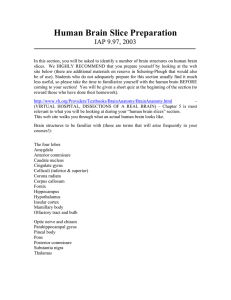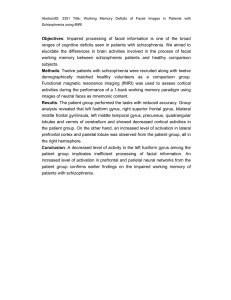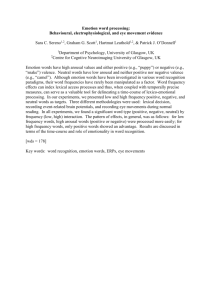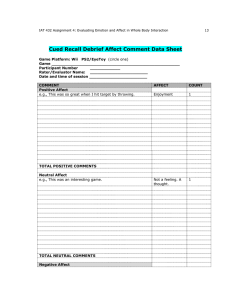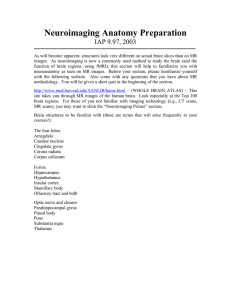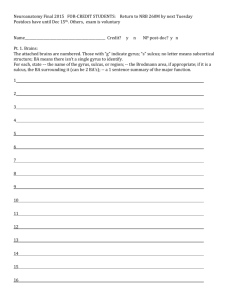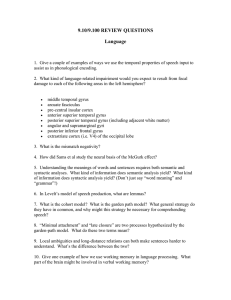The effect of emotional arousal and retention delay on subsequent
advertisement
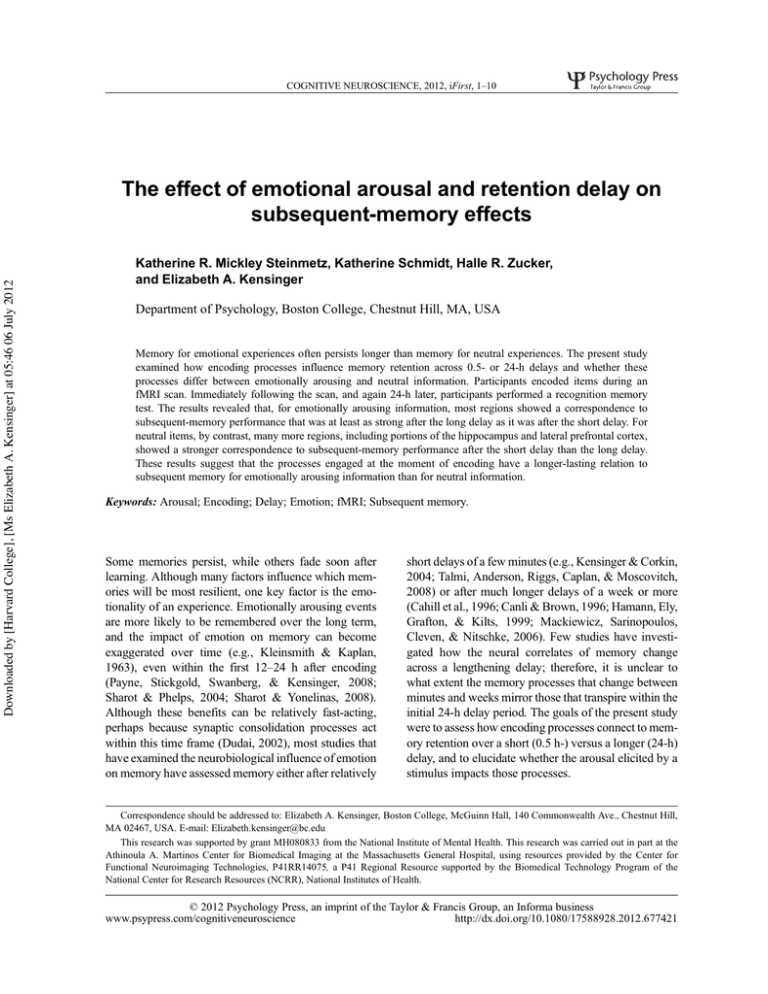
COGNITIVE NEUROSCIENCE, 2012, iFirst, 1–10 Downloaded by [Harvard College], [Ms Elizabeth A. Kensinger] at 05:46 06 July 2012 The effect of emotional arousal and retention delay on subsequent-memory effects Katherine R. Mickley Steinmetz, Katherine Schmidt, Halle R. Zucker, and Elizabeth A. Kensinger Department of Psychology, Boston College, Chestnut Hill, MA, USA Memory for emotional experiences often persists longer than memory for neutral experiences. The present study examined how encoding processes influence memory retention across 0.5- or 24-h delays and whether these processes differ between emotionally arousing and neutral information. Participants encoded items during an fMRI scan. Immediately following the scan, and again 24-h later, participants performed a recognition memory test. The results revealed that, for emotionally arousing information, most regions showed a correspondence to subsequent-memory performance that was at least as strong after the long delay as it was after the short delay. For neutral items, by contrast, many more regions, including portions of the hippocampus and lateral prefrontal cortex, showed a stronger correspondence to subsequent-memory performance after the short delay than the long delay. These results suggest that the processes engaged at the moment of encoding have a longer-lasting relation to subsequent memory for emotionally arousing information than for neutral information. Keywords: Arousal; Encoding; Delay; Emotion; fMRI; Subsequent memory. Some memories persist, while others fade soon after learning. Although many factors influence which memories will be most resilient, one key factor is the emotionality of an experience. Emotionally arousing events are more likely to be remembered over the long term, and the impact of emotion on memory can become exaggerated over time (e.g., Kleinsmith & Kaplan, 1963), even within the first 12–24 h after encoding (Payne, Stickgold, Swanberg, & Kensinger, 2008; Sharot & Phelps, 2004; Sharot & Yonelinas, 2008). Although these benefits can be relatively fast-acting, perhaps because synaptic consolidation processes act within this time frame (Dudai, 2002), most studies that have examined the neurobiological influence of emotion on memory have assessed memory either after relatively short delays of a few minutes (e.g., Kensinger & Corkin, 2004; Talmi, Anderson, Riggs, Caplan, & Moscovitch, 2008) or after much longer delays of a week or more (Cahill et al., 1996; Canli & Brown, 1996; Hamann, Ely, Grafton, & Kilts, 1999; Mackiewicz, Sarinopoulos, Cleven, & Nitschke, 2006). Few studies have investigated how the neural correlates of memory change across a lengthening delay; therefore, it is unclear to what extent the memory processes that change between minutes and weeks mirror those that transpire within the initial 24-h delay period. The goals of the present study were to assess how encoding processes connect to memory retention over a short (0.5 h-) versus a longer (24-h) delay, and to elucidate whether the arousal elicited by a stimulus impacts those processes. Correspondence should be addressed to: Elizabeth A. Kensinger, Boston College, McGuinn Hall, 140 Commonwealth Ave., Chestnut Hill, MA 02467, USA. E-mail: Elizabeth.kensinger@bc.edu This research was supported by grant MH080833 from the National Institute of Mental Health. This research was carried out in part at the Athinoula A. Martinos Center for Biomedical Imaging at the Massachusetts General Hospital, using resources provided by the Center for Functional Neuroimaging Technologies, P41RR14075, a P41 Regional Resource supported by the Biomedical Technology Program of the National Center for Research Resources (NCRR), National Institutes of Health. © 2012 Psychology Press, an imprint of the Taylor & Francis Group, an Informa business www.psypress.com/cognitiveneuroscience http://dx.doi.org/10.1080/17588928.2012.677421 Downloaded by [Harvard College], [Ms Elizabeth A. Kensinger] at 05:46 06 July 2012 2 MICKLEY STEINMETZ ET AL. The ability to retrieve a memory requires the successful completion of a number of processes, beginning with the encoding of the information. A large number of studies have confirmed that the processes engaged at the moment of encoding can have a strong influence over whether the information is later remembered or forgotten. When activation is elicited within the medial temporal lobe (MTL) and lateral prefrontal cortex (PFC), the likelihood of subsequent memory increases (reviewed by Paller & Wagner, 2002). There is a large degree of overlap between the processes that support the successful encoding of neutral and emotionally arousing information, yet there are also some notable differences (see Murty, Ritchey, Adcock, & LaBar, 2010 for a meta-analysis). The most reliable difference is that the amygdala is engaged during the successful encoding of emotionally arousing information, but not the successful encoding of neutral information (reviewed by LaBar & Cabeza, 2006). Regions within the orbital PFC also tend to have a stronger connection to the successful encoding of arousing information than neutral information, as do regions of the ventral visual processing stream, such as the fusiform gyrus (Murty et al., 2010). The vast majority of studies that have examined subsequent-memory performance––either for neutral information or for emotionally arousing information–– have assessed memory only for one delay (see Carr, Viskontas, Engel, & Knowlton, 2010; Ritchey, Dolcos, & Cabeza, 2008; Uncapher & Rugg, 2005, for exceptions). To date, only one study has compared the encoding processes that support subsequent memory withinsubjects over delays similar to those employed here: Uncapher and Rugg (2005) tested memory, for neutral items, after a 0.5-h delay and a 48-h delay. Their results revealed that encoding activity within the MTL and dorsolateral PFC showed a delay-invariant correspondence to subsequent-memory. There was, however, a shift from reliance on posterior regions (fusiform gyrus) to frontal regions (ventrolateral PFC) as the delay interval increased; as noted by the authors, this shift is consistent with evidence that, over time, memories for neutral information contain fewer verbatim details and instead are comprised of gist-based information (reviewed by Koriat, Goldsmith, & Pansky, 2000). A key question to be addressed by the present study was whether similar regions to these would show delayinvariant and delay-dependent subsequent-memory effects for emotionally arousing information. There was reason to believe that the posterior-to-anterior shift would be less likely to occur for emotionally arousing items than for neutral items, because high-arousal items can be remembered with high fidelity not only over short delays but also over relatively long delays of days (e.g., Kensinger, Garoff-Eaton, & Schacter, 2006) or weeks (e.g., Sharot, Verfaellie, & Yonelinas, 2007). Indeed, in the only prior study to examine the effect of delay on subsequent-memory effects for high-arousal information (Ritchey et al., 2008), the authors found evidence that fusiform activity was connected to the persistence of memory over a 1-week delay, and not just to short-term retention of information. On the basis of these prior findings, we hypothesized that, in comparison to neutral items, high-arousal items would show fewer delay-dependent, and more delay-invariant, subsequent-memory effects. This pattern of results would be consistent with current theories regarding the modulation of memory by arousal (reviewed by LaBar & Cabeza, 2006; McGaugh, 2004), which state that the ability to retrieve emotional memories after long delays can be accounted for by arousal-induced processes that are initiated at the moment of encoding. METHOD Participants Participants included 24 young adults. Data from three participants were unusable due to scanner or image projection malfunction. The remaining 21 participants (9 women) were an average age of 23.6 years (range ¼ 19–30 years) and had achieved an average of 15.8 years of education (range ¼ 12–20 years). Participants were right-handed and had been screened to exclude anyone with a history of neurological or psychiatric disease. All participants gave written informed consent for the study, approved by the Boston College and the Massachusetts General Hospital ethics boards. Materials Stimuli consisted of 300 high-arousal photos––half were positive: mean (SD) valence ¼ 7.21 (0.55), arousal ¼ 5.79 (0.57); half were negative1: valence ¼ 2.96 (0.83), arousal ¼ 5.83 (0.62) valence and arousal measured on 1 All effects reported here were consistent for positive and negative stimuli. Valence did, however, influence Dm effects (stronger Dm effects for negative items in posterior regions and for positive items in anterior regions, consistent with Mickley Steinmetz & Kensinger, 2009). At a reduced threshold, Dm effects for emotionally arousing items also were influenced by the interaction of valence and delay. The posterior-to-anterior effects were more pronounced at the short delay than the long delay, and laterality differences (right ¼ negative Dm, left ¼ positive Dm) were more pronounced at the long delay. Because these effects were not hypothesized a priori and did not meet the typical significance, we do not discuss them further. EMOTIONAL AROUSAL, MEMORY, AND DELAY Downloaded by [Harvard College], [Ms Elizabeth A. Kensinger] at 05:46 06 July 2012 9-point scales)––and 150 neutral photos: valence ¼ 5.03 (0.41), arousal ¼ 3.12 (0.86). Images were from the International Affective Picture System database (Lang, Bradley, & Cuthbert, 2008), with a few images supplemented from stimuli previously normed in our laboratory (Mickley Steinmetz & Kensinger, 2009). High-arousal and neutral pictures were matched on visual complexity, brightness, as indicated in Adobe Photoshop (Adobe Systems, San Jose, CA, USA), and picture content. Behavioral procedure Participants underwent a functional magnetic resonance imaging (fMRI) scan as they viewed 300 pictures (100 from each emotion category). Each picture was presented for 2000 ms. During this time, participants rated the photographic quality of the picture; this particular task was chosen because it did not force participants to process the affective content of the pictures. Interstimulus intervals were jittered, ranging from 2 to 14 s (Dale, 1999). Outside the scanner, after participants had changed into their street clothes, they underwent a surprise recognition test. Participants viewed pictures on a computer and indicated which items they had seen in the scanner. If an item was deemed “old,” the participant completed a modified Memory Characteristics Questionnaire (MCQ) (Johnson, Foley, Suengas, & Raye, 1988); responses to these questions will not be discussed here. After approximately a 24-h delay (range ¼ 23.5—27.0 h), participants returned to the laboratory and performed another recognition memory task; no pictures were repeated across the two memory tasks. At each delay, there were 225 pictures included on the recognition memory task: 2/3 of the images had been studied and 1/3 were included as unstudied foils. This ratio of old:new items was selected to parallel the methods used by Ritchey et al. (2008). Behavioral data analysis Corrected recognition scores were computed separately for items from each emotion category (high-arousal, neutral) and for items tested at each delay interval (short, long). Scores were calculated by subtracting the false-alarm rate for each item type from its respective hit rate (e.g., percent hit to neutral items at short delay minus percent false alarms to neutral items at short delay). MRI image acquisition and preprocessing procedure Data were acquired on a 1.5 Tesla Siemens wholebody Avanto MRI scanner (Erlangen, Germany), 3 using a 32-channel, high-resolution head coil. Anatomic data were acquired with an MP-RAGE sequence (TR ¼ 2730 ms, TE ¼ 3.39 ms, field of view ¼ 256 " 256 mm, acquisition matrix 256 x 256 x 128, slice thickness ¼ 1.33 mm). Functional images were acquired via a T2* weighted echo planar imaging sequence sensitive to the blood oxygenation leveldependent (BOLD) signal (TR ¼ 2000 ms, TE ¼ 40 ms, flip angle 90# ). Twenty-six interleaved axialoblique slices were collected in a 3.125 mm x 3.125 mm x 3.84 mm matrix, with the z dimension including a 20% gap. If full brain coverage was not achieved for any participant, slices were aligned such that orbitofrontal and ventral occipitotemporal cortices were always included within the field of view. Standard preprocessing (slice time correction, motion correction, normalization, and smoothing with a 5-mm kernel), and data analysis was completed with SPM5 (Statistical Parametric Mapping; Wellcome Department of Cognitive Neurology, London, UK). Event-related fMRI data analysis Encoding events were divided by the emotion category of the pictures (high-arousal, neutral), the subsequent-memory performance of the item (remembered, forgotten), and the delay after which memory for that item had been assessed (short delay, long delay). For each emotion category, participants had an average of 35 hits (and 15 misses) at the short delay, and 25 hits (and 25 misses) at the long delay. No participant had fewer than 7 items in any hit or miss category. A first-level, event-related subsequent-memory analysis (Dm) was completed: For each participant, on a voxel-by-voxel basis, event types were modeled through convolution with a canonical hemodynamic response function, comparing hits for a particular emotion category to misses for that emotion category. These Dm contrast images were then used for a secondlevel, random-effects group analysis, in which ANOVAs were computed with emotion category and delay as factors. We also computed first-level, eventrelated analyses for just the remembered items (vs. baseline) and for just the forgotten items (vs. baseline). These contrast images were used for additional secondlevel, random-effects ANOVAs with emotion category and delay as factors. For all whole-brain analyses, differences in activation were considered to be significant within regions consisting of at least five voxels, active at p < .001, unless otherwise specified. Monte Carlo simulations (Slotnick, Moo, Segal, & Hart, 2003) confirmed that 4 MICKLEY STEINMETZ ET AL. this p value and voxel extent combination corrected results for multiple comparisons at p < .05. Voxel coordinates are reported in Talairach (TAL) coordinates at the most significant voxel in each cluster (Talairach & Tournoux, 1988), and data are displayed on canonical images provided within SPM5. RESULTS Downloaded by [Harvard College], [Ms Elizabeth A. Kensinger] at 05:46 06 July 2012 Behavioral results An ANOVA conducted on the corrected recognition rates (see Table 1 for hit and false-alarm values) revealed a main effect of emotion category, F(1, 20) ¼ 20.8, p < .001, η2 ¼ .51, with better memory for high-arousal items than for neutral items. The ANOVA also revealed a main effect of delay, F(1, 20) ¼ 146.9, p < .001, η2 ¼ .88, with better memory after the short delay than the long delay. There was no interaction between emotion category and delay, F(1, 20) < 1, p > .15. TABLE 1 Mean (SD) recognition performance as a function of emotion category and delay High Arousal Hits False Alarms Neutral Hits False Alarms Short Delay Long Delay .74 (.03) .02 (.03) .53 (.20) .03 (.04) .67 (.17) .05 (.04) .43 (.20) .05 (.04) Dm effects Collapsing across emotion and delay, we replicated the standard Dm effects (reviewed by Paller & Wagner, 2002) within the lateral PFC, MTL (TAL coordinates: 22, -5, -15), lateral parietal cortex, precuneus, and ventral visual processing stream (see Figure 1A, regions in red and the top portion of Table 2 for a list of all regions). Analyses also replicated prior findings (see Murty et al., 2010) with regard to Dm effects modulated by emotion. When collapsing across delay, regions within the medial and orbital PFC, amygdala (TAL coordinates: -34, -1, -18), and posterior hippocampus (TAL coordinates: 34, -20, -7) showed a stronger Dm effect for emotionally arousing items than neutral items (see Figure 1B, regions in yellow, and the lower panel of Table 2 for a list of all regions). Effect of delay and emotion on Dm effects When we examined the effect of delay on Dm effects for neutral items, many regions showed a stronger Dm effect after the short delay than after the long delay (blue regions in top left panel of Figure 2), including regions within the ventromedial PFC (TAL coordinates: 8, 21, -1), the parahippocampal gyrus (TAL coordinates: -20, -43, 2), and throughout the ventral visual processing stream (Brodmann areas 19 and 37). By contrast, only a single region of the superior temporal gyrus (TAL coordinates: -48, -6, -10) showed a stronger Dm effect for neutral items after a long than a short delay. Figure 1. When collapsing across delay, the results replicated prior findings with regard to the regions that showed a Dm effect, collapsing across all items (panel A, regions in red) or those that showed a stronger Dm effect for emotionally arousing items than for neutral items (panel B, regions in yellow). The y value of the Talairach coordinates are indicated for each coronal slice. EMOTIONAL AROUSAL, MEMORY, AND DELAY 5 TABLE 2 Regions showing an overall Dm effect (top portion) and a Dm effect that is greater for emotional than neutral items (bottom portion). Regions significant at p < .001. Hemi ¼ hemisphere, BA ¼ Brodmann area, TAL ¼ Talairach, MNI ¼ Montreal Neurological Institute, K ¼ cluster size (voxel extent) Overall Dm effect Location Frontal Region Inferior frontal gyrus Downloaded by [Harvard College], [Ms Elizabeth A. Kensinger] at 05:46 06 July 2012 Middle frontal gyrus Limbic Occipital Parietal Cingulate gyrus/ dorsomedial prefrontal cortex Superior frontal gyrus Anterior cingulate gyrus Amygdala/anterior hippocampus Posterior cingulate gyrus Cuneus Fusiform gyrus Middle occipital gyrus Precuneus Inferior parietal lobule Superior parietal lobule Temporal Fusiform gyrus Inferior temporal gyrus Middle temporal gyrus Superior temporal gyrus Cerebellum Hemi Left Right Left Right Right Right Left Right Left Right Right Left Left Left Left Left Right Right Right Left Right Left Right Right Right Right Right Left Right Right Left Right Left Right Right BA 45 45 44 10 9 10 46 5 8 19 19 18 19 18 40 40 7 5 36 37 21 19 21 39 22 22 22 22 22 TAL coordinates MNI coordinates (x, y, z) (x, y, z) K Z -55, 28, 12 46, 19, 21 -38, 9, 18 30, 60, -5 8, 40, 20 28, 57, 5 -36, 46, 22 8, -25, 44 -14, 49, 42 12, 25, -3 22, -5, -15 -10, -45, 23 -26, -86, 37 -32, -80, -6 -38, -89, 10 -36, -77, 20 22, -93, 6 10, -74, 28 53, -52, 41 -50, -60, 44 30, -64, 40 -10, -36, 50 28, -28, -17 48, -51, -8 63, -16, -8 44, -73, 18 65, -4, -1 -42, -62, 3 46, -33, 3 63, -19, 6 -53, -2, 0 53, -4, 8 -50, -40, 20 14, -61, -12 40, -61, -15 -56, 28, 14 46, 18, 24 -38, 8, 20 30, 62, -2 8, 40, 24 28, 58, 8 -36, 46, 26 8, -28, 46 -14, 48, 48 12, 26, -2 22, -4, -18 -10, -48, 22 -26, -90, 36 -32, -82, -12 -38, -92, 6 -36, -80, 18 22, -96, 2 10, -78, 26 54, -56, 42 -50, -64, 44 30, -68, 40 -10, -40, 52 28, -28, -22 48, -52, -12 64, -16, -10 44, -76, 16 66, -4, -2 -42, -64, 0 46, -34, 2 64, -20, 6 -54, -2, 0 54, -4, 8 -50, -42, 20 14, -62, -18 40, -62, -22 13 10 6 62 379 1483 592 612 38 67 8 18 39 1122 100 13 7 1400 837 125 92 11 66 539 214 191 9 14 22 22 12 8 22 8 5 3.54 3.53 3.51 5.67 5.46 5.38 4.97 5.28 4.79 4.4 3.8 3.66 4.48 5.26 5.03 3.81 3.37 5.72 6.17 4.57 4.09 3.59 4.23 5.6 5.28 4.5 3.52 3.4 3.93 3.8 3.62 3.59 3.46 3.58 3.32 0, 61, 25 -22, 31, 33 24, 33, 39 -12, 40, 18 2, 46, 20 -2, 51, 12 -16, -11, 54 6, -9, 45 8, -51, 27 4, 21, 25 18, 43, 7 34, -20, -7 -34, -1, -18 44, -13, 8 36, -10, -6 -38, -78, 37 -2, -61, 58 -2, -61, 33 -8, -38, 52 16, -44, 54 0, 62, 30 -22, 30, 38 24, 32, 44 -12, 40, 22 2, 46, 24 -2, 52, 16 -16, -14, 58 6, -12, 48 8, -54, 26 4, 20, 28 18, 44, 10 34, -20, -10 -34, 0, -22 44, -14, 8 36, -10, -8 -38, -82, 36 -2, -66, 60 -2, -64, 32 -8, -42, 54 16, -48, 56 39 6 28 6 32 34 35 10 10 44 5 11 10 21 5 6 23 17 5 14 3.68 2.91 3.34 2.81 3.38 3.12 3.37 2.94 2.95 3.23 2.76 3.32 2.75 3.24 3.13 2.69 3.24 2.99 2.86 2.87 Dm effects emotion > neutral Frontal Superior frontal gyrus Limbic Cingulate/superior frontal gyrus Cingulate gyrus Hippocampus Amygdala Insular gyrus Parietal Angular gyrus Precuneus Superior parietal lobule Bilateral Left Right Left Right Left Left Right Right Right Right Right Left Right Right Left Left Left Left Right 10 46/9 8/9 9 32 10 6 24 23 24 32 41 34 41 41 19 7 31 7 7/5 (Continued ) 6 MICKLEY STEINMETZ ET AL. TABLE 2 (Continued) Dm effects emotion > neutral TAL coordinates Downloaded by [Harvard College], [Ms Elizabeth A. Kensinger] at 05:46 06 July 2012 Location Region Temporal Middle temporal gyrus Superior temporal gyrus Other Caudate nucleus Hypothalamus Thalamus MNI coordinates Hemi BA (x, y, z) (x, y, z) K Z Right Right Right Right Right Right Left Right Left 21/22 39 39/22 22 22 22 24 near 34 27 59, -54, 8 42, -64, 31 46, -55, 23 55, -45, 24 40, -42, 11 67, -38, 18 -12, -1, 24 2, -10, -5 -20, -27, 5 60, -56, 6 42, -68, 30 46, -58, 22 56, -48, 24 40, -44, 10 68, -40, 18 -12, -2, 26 2, -10, -6 -20, -28, 4 27 5 76 5 17 11 12 10 5 2.88 2.76 3.87 2.86 2.92 2.95 3.21 2.99 3.46 Figure 2. Regions showing a Dm effect that interacted with delay (top panels) or that was delay invariant (bottom panel). All activations are shown at p < .001 (see text for details). In the top panels, blue regions showed a stronger Dm effect at the short than the long delay; green regions showed the opposite pattern. In the bottom panel, all regions showed a significant Dm effect (p < .001) and no influence of delay on the magnitude of that Dm effect (p > .05). Red regions showed the delay-invariant Dm effect for neutral items, and yellow regions showed the delay-invariant effect for emotionally arousing items. Orange reveals the area of overlap of those two whole-brain maps. The y Talairach coordinates are indicated for each coronal slice. Downloaded by [Harvard College], [Ms Elizabeth A. Kensinger] at 05:46 06 July 2012 EMOTIONAL AROUSAL, MEMORY, AND DELAY The pattern was not the same for emotionally arousing items, however (see upper right panel of Figure 2). Confirming this difference, a number of regions showed a Dm effect that was influenced by the interaction between emotion and delay (see Table 3). In nearly all regions that showed this interaction, including regions of the ventromedial PFC (TAL coordinates: 8, 23, -1), fusiform (TAL coordinates: -30, -47, -16), and hippocampus (TAL coordinates: 36, -29, -5), there was a stronger Dm effect after a short than a long delay only for the neutral items; for emotionally arousing items, there was either an equally strong correspondence to subsequent memory regardless of the delay after which memory was tested, or the correspondence to subsequent memory was stronger when memory was tested after the long delay. Among the regions that showed a Dm effect that was influenced by the interaction between emotion and delay, we examined whether this interaction arose for remembered items or for forgotten items. For items later forgotten, differential activation at the short versus the long delay was present for neutral but not for emotional items. By contrast, for items later remembered, activation generally was equally strong regardless of emotion category or delay. In other words, the effect of emotion and delay on the Dm effect may be driven by the pattern of activation to forgotten items (see the right columns of Table 3). Although most regions showed the interaction because of the activation to forgotten items, there were two exceptions to this pattern. The first was within medial regions, which showed an interaction for both remembered and forgotten items (ventromedial PFC, cingulate gyrus) or for only remembered items (precuneus). The second exception was within regions connected to sensory processing; these regions seemed particularly tied to the relative activation differences between remembered and forgotten items, showing an interaction either for both remembered and forgotten items (lingual and parahippocampal gyrus) or for neither item type when considered in isolation (middle occipital gyrus, fusiform gyrus). Delay-invariant Dm effects To reveal regions showing a delay-invariant Dm effect, we used exclusive masking to isolate regions that showed an overall Dm effect (at p < .001) and also no significant effect of delay on that Dm effect (p > .05). For neutral stimuli (red regions in lower panel of Figure 2), a number of regions showed this delayinvariant correspondence to subsequent memory, 7 including a region of the parahippocampal cortex (TAL coordinates: 34, -28, -15) in close proximity to a region identified previously by Uncapher and Rugg (2005) (TAL coordinates: 30, -24, -19). A number of regions showed this correspondence for emotionally arousing items as well (yellow regions of Figure 2), and there was extensive overlap in delay-invariant Dm effects for the two item types. GENERAL DISCUSSION Our results confirm that there are both delay-dependent and delay-invariant Dm effects. For neutral items, the delay-dependent effects generally revealed a more tenuous link between encoding processes and subsequentmemory at the longer (24-h) delay than the shorter (0.5-h) one. For arousing items, more of the processes engaged at the moment of encoding had a long-lasting impact on subsequent-memory performance, consistent with modern theories which state that when arousal is elicited during encoding, it initiates a cascade of processes that lead to the creation of durable memory traces (reviewed by LaBar & Cabeza, 2006; McGaugh, 2004). Effect of delay on subsequent-memory effects for neutral information For neutral items, the majority of delay-dependent effects reflected activity that showed a strong correspondence to subsequent memory after a short delay but that failed to show a relation to subsequent memory after the long delay. In many of the regions, encoding activity was equivalently high whenever the items were remembered, regardless of the emotion category or the delay after which memory was assessed, but activation was particularly low when neutral items were forgotten after a short delay. These results suggest that forgetting over the 0.5-h delay may reflect a fault in the encoding process, whereas forgetting over longer delays may occur even when encoding processes were engaged. It is also interesting to note that, as in the study by Uncapher and Rugg (2005), activation in the fusiform gyrus was more predictive of subsequent memory over the short delay than the longer one, consistent with the proposal that the link between sensory engagement and memory degrades as time progresses (Koriat et al., 2000). We did not find evidence of increased lateral PFC activity for longer-lasting subsequent-memory effects, although we did find increased superior PFC 8, 23, -1 3.58 2.99 3.03 2.91 3.03 3.29 2.85 3.53 3.74 3.85 3.45 3.89 3.62 3.82 3.37 3.31 3.6 3.64 3.46 3.43 3.38 4.15 Yes No No No No No No Yes Yes Yes Yes Yes Yes Yes Yes No Yes Yes Yes No No Yes Yes Significant interaction for forgotten trials?* -22,–43,–8 -59,-37, 4 3.27 38,–27, -4 4, 16, 3 20,26,12 same -38,–1, 11 32,–28, 27 same 22,27,–6 same 34,–18, 34 -12, 5, 57 8, 23, -3 3.46 3.27 3.58 3.56 3.49 3.9 3.3 3.62 3.51 2.81 2.81 3.96 3.77 Z TAL for forgotten ANOVA Yes No No No No No No No No No No No No Yes No No No No No Yes No Yes Yes Significant interaction for remembered trials? 3.18 3.29 2.91 3.12 3.32 Z 0, 18, 10 -18, -43, -8 -22, -65, 24 18, 29, 6 10, 25, 1 TAL for remembered ANOVA Notes: * Because in a Dm analysis activation to forgotten items is subtracted from activation to remembered items, the interaction for the forgotten items was opposite in direction from the interaction for the overall Dm effect or for the remembered items. Temporal Parietal Occipital Right Right Right Right Left Right Right Left Right Left Right Left Left Left Z 8, 24, 0 23 4.59 K 28 6 6 13 8 11 10 6 24 (x, y, z) (x, y, z) Emotion " delay interaction: (emotionally arousing short > long) > (neutral short > long) Other Striatum Bilateral 33 0, 16, 8 0, 16, 10 Frontal Precentral gyrus Left 4 -18, -21, 42 -18, -24, 44 Superior frontal gyrus Right 9 8, 51, 20 8, 52, 24 Limbic Cingulate gyrus Right 23 10, -40, 22 10, -42, 22 Insular gyrus Left 44 -28, 13, 18 -28, 12, 20 Parietal Supramarginal gyrus Right 40 45, -31, 33 46, -34, 34 Temporal Inferior temporal gyrus Right 38/21 36, 10, -24 36, 12, -28 Middle temporal gyrus Left 21/22 -58, -37, 2 -58, -38, 0 Superior frontal gyrus Cingulate gyrus Hippocampus Middle occipital gyrus Insular gyrus Insular gyrus Inferior parietal lobe Precuneus Fusiform gyrus Spanning lingual gyrus and parahippocampal gyrus Limbic Right BA 9 12 10 8 6 20 7 10 6 6 11 6 7 21 Spanning cingulate gyrus and ventromedial PFC Middle frontal gyrus Orbital gyrus Precentral gyrus Frontal Hemi 4 34, -10, 37 34, -12, 40 32 22, 25, -8 22, 26, -8 4 26, -25, 51 26, -28, 54 1 34, -20, 34 34, -22, 36 6 -12, 7, 57 -12, 4, 62 24 18, 28, 8 18, 28, 10 20 36, -29, -5 36, -30, -8 19 -34, -79, 17 -34, -82, 14 45 30, 18, 6 30, 18, 8 4 -40, -3, 11 -40, -4, 12 40 30, -30, 29 30, -32, 30 31/39 -24, -63, 23 -24, -66, 22 37 -30, -47, -16 -30, -48, -22 35 -20, -43, -6 -20, -44, -10 Region Location MNI coordinates TAL coordinates Emotion " delay interaction: (neutral short > long) > (emotionally arousing short > long) TABLE 3 Regions showing a Dm effect that is influenced by the interaction of emotion category and delay. The top portion of the table lists regions that show a larger Dm effect at the short delay than the long delay for neutral items, but not for emotionally arousing items. The bottom portion of the table lists regions that show the opposite pattern. Right columns indicate if this interaction between delay and emotion was also significant when only forgotten trials, or only remembered trials, were entered into an ANOVA. Regions are significant at p <.001 except where highlighted in gray (p < .005). Hemi ¼ hemisphere, BA ¼ Brodmann area, TAL ¼ Talairach, MNI ¼ Montreal Neurological Institute, K ¼ cluster size (voxel extent) Downloaded by [Harvard College], [Ms Elizabeth A. Kensinger] at 05:46 06 July 2012 8 MICKLEY STEINMETZ ET AL. EMOTIONAL AROUSAL, MEMORY, AND DELAY Downloaded by [Harvard College], [Ms Elizabeth A. Kensinger] at 05:46 06 July 2012 and anterior temporal lobe reliance, which could be consistent with a shift toward dependence on extracted semantic information rather than sensory detail (Koriat et al., 2000). Thus, both studies reveal that there can be a shift in the encoding processes that correspond with subsequent memory even over delays that are within a relatively narrow time frame (0.5–h to 24 h in this study, and 0.5 h to 48 h in Uncapher & Rugg, 2005). Effect of delay on subsequent-memory effects for emotionally arousing information Consistent with our hypothesis, there was no evidence of a posterior-to-anterior shift in the Dm effects for emotionally arousing items as the delay interval increased. Also, in contrast to neutral items, Dm effects for emotionally arousing information were rarely stronger at the short delay than the long delay; Dm effects were either delay-invariant or intensified with the longer delay. This finding is consistent with Ritchey et al. (2008), who found no differences in the activation levels corresponding with memory performance for emotional items at 20min and 1-week delays (although they did find some connectivity differences). What is particularly novel about the present study, however, is that it emphasizes that emotionally arousing items have a greater tendency than neutral items to have delay-invariant Dm effects, or to have Dm effects that strengthen, rather than weaken, over a delay. Thus, the processes engaged at the moment of encoding have a longer-lasting connection to whether information will be remembered or forgotten if that information elicits arousal than if it does not. Concluding remarks The current study reveals that, even when memory is assessed over a relatively narrow time frame (i.e., 0.5 h to 24 h), there are diminishing returns on the efficacy of encoding processes for predicting subsequent memory for neutral items. Yet there is a longer-lasting relation between encoding processes and subsequent-memory performance when information elicits arousal. These findings are consistent with the proposal that arousalinduced processes at the moment of encoding trigger a cascade of processes that continue to preserve a memory, even over longer delays. Original manuscript received 12 November 2011 Revised manuscript accepted 18 February 2012 First published online 4 May 2012 9 REFERENCES Cahill, L., Haier, R. J., Fallon, J., Alkire, M. T., Tang, C., Keator, D., et al. (1996). Amygdala activity at encoding correlated with long-term, free recall of emotional information. Proceedings of the National Academy of Sciences of the United States of America, 93, 8016–8021. Canli, T., & Brown, T. H. (1996). Amygdala stimulation enhances the rat eyeblink reflex through a short-latency mechanism. Behavioral Neuroscience, 110(1), 51–59. Carr, V. A., Viskontas, I. V., Engel, S. A., & Knowlton, B. J. (2010). Neural activity in the hippocampus and perirhinal cortex during encoding is associated with the durability of episodic memory. Journal of Cognitive Neuroscience, 22 (11), 2652–2662. Dale, A. M. (1999). Optimal experimental design for eventrelated fMRI. Human Brain Mapping, 8, 109–114. Dudai, Y. (2002). Molecular bases of long-term memories: A question of persistence. Current Opinion in Neurobiology, 12(2), 211–216. Hamann, S. B., Ely, T. D., Grafton, S. T., & Kilts, C. D. (1999). Amygdala activity related to enhanced memory for pleasant and aversive stimuli. Nature Neuroscience, 2(3), 289–293. Johnson, M. K., Foley, M. A., Suengas, A. G., & Raye, C. L. (1988). Phenomenal characteristics of memories for perceived and imagined autobiographical events. Journal of Experimental Psychology: General, 117(4), 371–376. Kensinger, E. A., & Corkin, S. (2004). Two routes to emotional memory: Distinct neural processes for valence and arousal. Proceedings of the National Academy of Sciences of the United States of America, 101(9), 3310–3315. Kensinger, E. A., Garoff-Eaton, R. J., & Schacter, D. L. (2006). Memory for specific visual details can be enhanced by negative arousing content. Journal of Memory and Language, 54, 99–112. Kleinsmith, L. J., & Kaplan, S. (1963). Paired-associate learning as a function of arousal and interpolated interval. Journal of Experimental Psychology, 65, 190–193. Koriat, A., Goldsmith, M., & Pansky, A. (2000). Toward a psychology of memory accuracy. Annual Review of Psychology, 51, 481–537. LaBar, K. S., & Cabeza, R. (2006). Cognitive neuroscience of emotional memory. Nature Reviews Neuroscience, 7, 54–64. Lang, P. J., Bradley, M. M., & Cuthbert, B. N. (2008). International Affective Picture System (IAPS): Affective ratings of pictures and instruction manual. Technical Report A-8. University of Florida, Gainesville, FL. Mackiewicz, K. L., Sarinopoulos, I., Cleven, K. L., & Nitschke, J. B. (2006). The effect of anticipation and the specificity of sex differences for amygdala and hippocampus function in emotional memory. Proceedings of the National Academy of Sciences of the United States of America, 103(38), 14200–14205. McGaugh, J. L. (2004). The amygdala modulates the consolidation of memories of emotionally arousing experiences. Annual Review of Neuroscience, 27, 1–28. Mickley Steinmetz, K. R., & Kensinger, E. A. (2009). The effects of valence and arousal on the neural activity leading to subsequent memory. Psychophysiology, 46(6), 1190–1199. Murty, V. P., Ritchey, M., Adcock, R. A., & LaBar, K. S. (2010). fMRI studies of successful emotional memory encoding: Downloaded by [Harvard College], [Ms Elizabeth A. Kensinger] at 05:46 06 July 2012 10 MICKLEY STEINMETZ ET AL. A quantitative meta-analysis. Neuropsychologia, 48, 3459–3469. Paller, K. A., & Wagner, A. D. (2002). Observing the transformation of experience into memory. Trends in Cognitive Sciences, 6(2), 93–102. Payne, J. D., Stickgold, R., Swanberg, K., & Kensinger, E. A. (2008). Sleep preferentially enhances memory for emotional components of scenes. Psychological Science, 19 (8), 781–788. Ritchey, M., Dolcos, F., & Cabeza, R. (2008). Role of amygdala connectivity in the persistence of emotional memories over time: An event-related fMRI investigation. Cerebral Cortex, 18, 2494–2504. Sharot, T., & Phelps, E. A. (2004). How arousal modulates memory: Disentangling the effects of attention and retention. Cognitive, Affective, and Behavioral Neuroscience, 4(3), 294–306. Sharot, T., Verfaellie, M., & Yonelinas, A. P. (2007). How emotion strengthens the recollective experience: A timedependent hippocampal process. PLoS ONE, 2(10), 1–10. Sharot, T., & Yonelinas, A. P. (2008). Differential timedependent effects of emotion on recollective experience and memory for contextual information. Cognition, 106, 538–547. Slotnick, S. D., Moo, L. R., Segal, J. B., & Hart, J. (2003). Distinct prefrontal cortex activity associated with item memory and source memory for visual shapes. Cognitive Brain Research, 17, 75–82. Talairach, J., & Tournoux, P. (1988). Co-planar stereotaxic atlas of the human brain: 3-dimensional proportional system: An approach to cerebral imaging. M. Rayport, trans. New York, NY: Thieme. Talmi, D., Anderson, A. K., Riggs, L., Caplan, J. B., & Moscovitch, M. (2008). Immediate memory consequences of the effect of emotion on attention to pictures. Learning and Memory, 15, 172–182. Uncapher, M. R., & Rugg, M. D. (2005). Encoding and the durability of episodic memory: A functional magnetic resonance imaging study. Journal of Neuroscience, 25 (31), 7260–7267.

